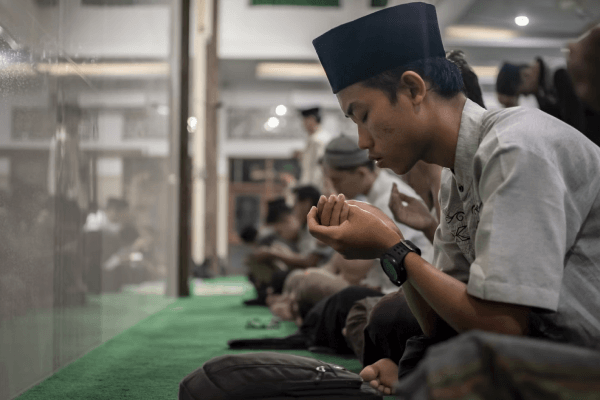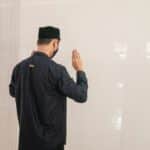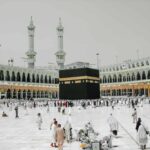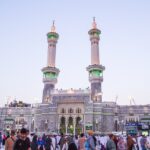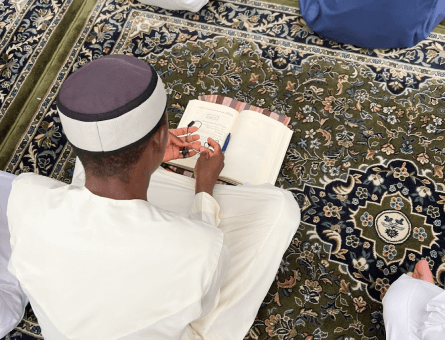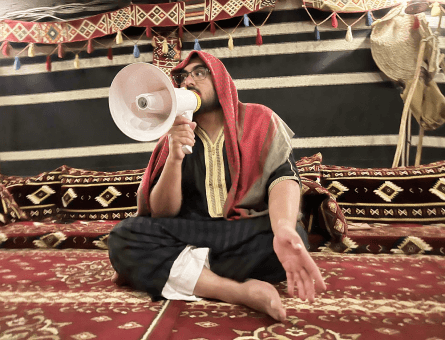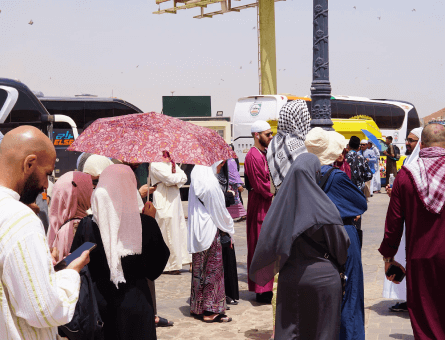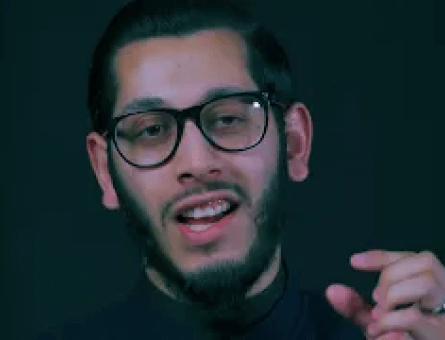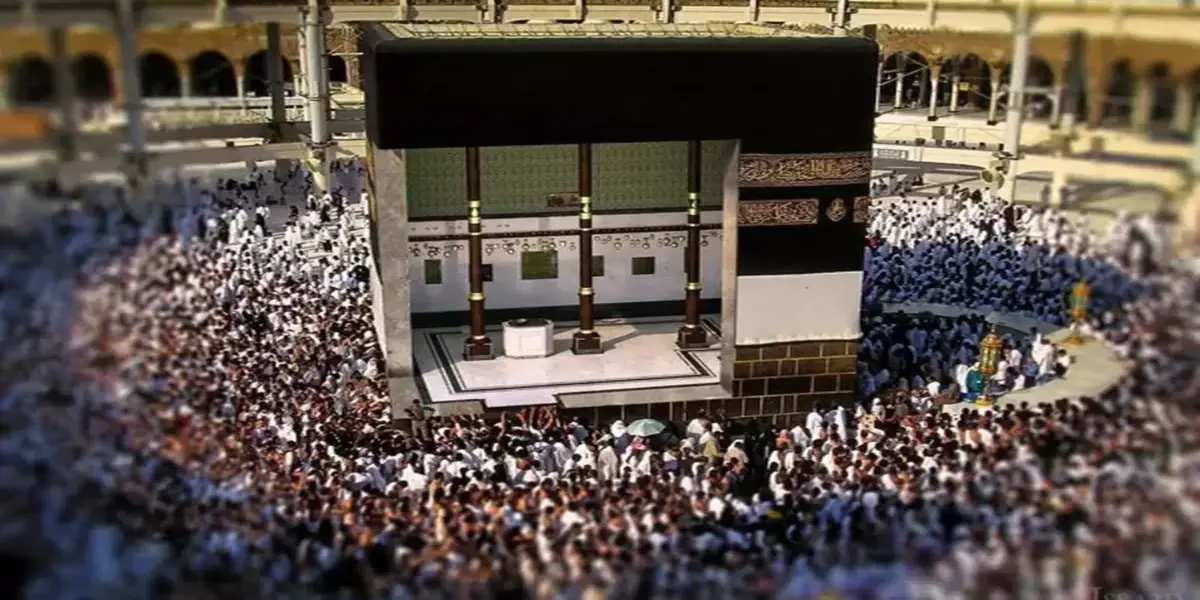What is inside the Kaaba? – Find out what is inside one of Islam’s holiest sites
Also called Khana Kaaba, the Holy Kaaba, literally meaning “cube,” is a small cube located at the centre of Masjid Al Haram – the Great Mosque – in Mecca, Saudi Arabia. Covered with a sacred black silk cloth called Kiswah, the Holy Kaaba holds great importance in terms of Islam’s history, culture, and tradition. Every year, thousands of Muslims visit the Holy Kaaba to perform Umrah or Hajj. They circle seven times around the Kaaba in an anti-clockwise direction, praying to Allah SWT. But do you know what’s inside the Kaaba?
In a polygon-shaped interior that doesn’t exceed 180 meters square, the interior of the Holy Kaaba comprises the following:
- Three wooden pillars to support the ceiling
- Number of suspended gold and silver lamps
- Enclosed stairway leading to a hatch
- Bab al-Tawbah – Golden Door
- Fabric trimming
- Eight stones decorated with Arabic calligraphy
Can You Go Inside the Holy Kaaba?
Technically, Muslims aren’t allowed to go inside the Holy Kaaba. However, if you are wondering what you will find here, the Kaaba is roughly 15 meters (50 feet) high and is about 10 by 14 meters (35 by 40 feet) at the base. Strategically constructed using marble and gray stone, the structure of the Kaaba was designed to align with the cardinal directions. The enclosed interior of the Kaaba has no windows but just a door embedded with silver engravings and covered with a silk curtain of gold. The roof and half of the walls are covered with green cloth. The remaining half is engraved with calligraphies of Shahada, and also there is a marking on the floor to highlight the place where Prophet Muhammad (PBUH) prayed.
“Today, only people who are authorized by the Al-Shaibi family, guardians of the Kaaba, are allowed to pray inside the sacred monument twice a year, including government officials, exclusive guests, and dignitaries.”
How to Get into the Kaaba
The government of Saudi Arabia is very strict about who can enter the Holy Kaaba and who can’t. The odds of non-Muslims entering the blessed space are close to none. Although currently, only Muslim dignitaries are permitted to enter the Kaaba to pray. However, if you want to pray inside the Kaaba, you can recite two Rakaats in Hateem, a curved-shaped area adjacent to the Holy Kaaba. According to Hazrat Aisha (RA)’s narration, she asked Prophet Muhammad (PBUH) if she could pray inside the Kaaba. He (PBUH) told her that she could pray in the area of Hateem as it is a part of the Kaaba.
If one were to pray inside the Kaaba, they would be able to pray in any direction.
Why Is the Kaaba Important to Muslims?
The House of Allah, the Holy Kaaba holds great importance in the lives and hearts of the Muslim Ummah. According to Islamic beliefs, the sacred structure is a sign of Oneness and the Supreme Power of Allah SWT. Before Islam, the Kaaba was the centre of worship for pre-Islamic groups; it was always filled with idols and gods that were placed there by people of other faiths. It is said that after the revelation of Islam, Prophet Muhammad (PBUH) received instructions from Allah SWT to restore the Holy Kaaba into a place to worship the Creator, the Eternal and Absolute Allah SWT. The restoration of the Holy Kaaba marked the end of polytheism among groups, and it also became the centre of worship for the followers of Islam.
Apart from being a safe house, the presence and standing of Hajre Aswad (Black Stone) and the Holy Kaaba are also a symbol of unification of Muslims to the world. No Muslim worships the Kaaba or the Black Stone. Instead, they stand together and pray to the Supreme Power that is Allah SWT. Moreover, the Holy Kaaba is also the direction of Qibla; Muslims worldwide face the Holy Kaaba while offering their daily prayers.
Why Is the Kaaba Covered in a Black Cloth?
Made from the highest quality of silk and embroidered with silver and gold thread, Kiswah has a long and rich history. From a white cloth with red stripes to an all-white cloth to a green one and finally, a black coloured one, the colours of Kiswah have changed over time. The primary purpose of the Kiswah is to protect and honour the holiest and most sacred place in Islam.
Adorned with verses of the Quran, the kiswah symbolizes the sanctity and significance of the Ka’bah as the focal point of Muslim worship and unity
The Quraysh and the Kaaba
During the time of Quraysh, not only did the Kaaba have two doors (eastern and western side) at the ground level, but it also had no roof. The Quraysh used the Kaaba primarily for two purposes; to deposit their valuables and to worship. However, five years before Prophethood, the Quraysh themselves rebuilt the Kaaba; they raised the eastern door to better control who entered the Kaaba and closed the western one forever. Moreover, the Quraysh, along with the young Prophet Muhammad (PBUH) also constructed a roof for the first time.
After the construction of the Kaaba was completed, the Quraysh placed their chief idol Hubal – made from red carnelian – in a human-like shape with a gold right hand in the centre of the Kaaba. In front of the idol, the Quraysh placed seven arrows of fate which helped them depict their future.
When Islam began to spread, the Quraysh became furious and couldn’t tolerate the teachings of Prophet Muhammad (PBUH) anymore. Therefore, the chiefs called an economical and social boycott of Prophet Muhammad (PBUH), his (PBUH) family, and all those who supported him (PBUH); the boycott document was hung inside the Kaaba to give it full sanctity. For the next three years, Prophet Muhammad (PBUH) and the followers took shelter in a narrow valley called Sheeb Abi Talib. However, due to scarcity of food and water, the cries of children could be heard all across the valley. Miraculously, one day, by the Grace of Allah SWT, the entire document of the boycott was eaten by white ants except for the name Allah, resulting in the dissolution of the boycott.
Changes to the Kaaba Throughout History
After the conquest of Makkah, Prophet Muhammad (PBUH), along with Usama bin Zaid and Hazrat Bilal (RA), performed tawaf seven times around the Kaaba and touched Hajre Aswad with his staff. He (PBUH) then opened the door, went inside the Kaaba, and prayed there for some time. At that time, the interior of the Kaaba was filled with pictures of angels, Prophet Ibrahim (AS), Prophet Ismail (AS), baby Jesus (AS), Virgin Mary (AS), and several idols. Prophet Muhammad (PBUH) ordered everything to be destroyed, including the chief Hubal. Abdullah bin Zubair (RA) created three wooden pillars for additional support inside the Holy Kaaba. Since then, the interior of the Holy Kaaba has been maintained in the same way by different rulers such that the walls of the Kaaba act as plaques commemorating the renovative work done by different rulers. However, even today, the inside of the Kaaba is not accessible to the common man.
Interesting Scientific Facts about the Kaaba
Here are some interesting facts about the Holy Kaaba that you didn’t know:
- Hazrat Kharrija bin Musa’b (RA) narrates that once four people completed the recitation of the Quran inside the Kaaba in a single Rakaat. These people included Hazrat Usman (RA), Hazrat Tamim Dari (RA), Iman Abu Hanifa (Rehmat-Ullah Illahi), and Hazrat Sa’eed bin Jubayr (RA).
- During the reconstruction of the Holy Kaaba, two horns of the ram (sheep) that Hazrat Ibrahim (AS) slaughtered were found by Abdullah bin Zubair (RA) hanging inside the Holy Kaaba. However, the horns had disintegrated due to old age and previous damages.
- During the period of Ignorance (Jahiliyyah), a Yemenite woman and man named Na’ilah and Isaf committed adultery inside the Kaaba. In punishment for the sin, Allah SWT turned them into stones. The two stones were initially set outside the Kaaba as a warning; however, people started worshiping them with time. One stone was placed adjacent to spring Zamzam, while the other was placed next to the Kaaba. After some time, the Quraysh ordered the stones beside the Kaaba to be placed next to Zamzam. Since then, people have slaughtered their sacrificial animals on the same spot.
Summary – Inside the Kaaba
From the wooden pillars supporting the roof to the golden, silver lamps, calligraphy on the walls, and the golden door, the interior of the Kaaba is a sight every Muslim must see. If you wish to pray inside the Holy Kaaba, pray two Rakaats inside the Hateem as it is also a part of the Holy Kaaba.
Through His Names
New course with
Ustadh Shabbir Hassan




